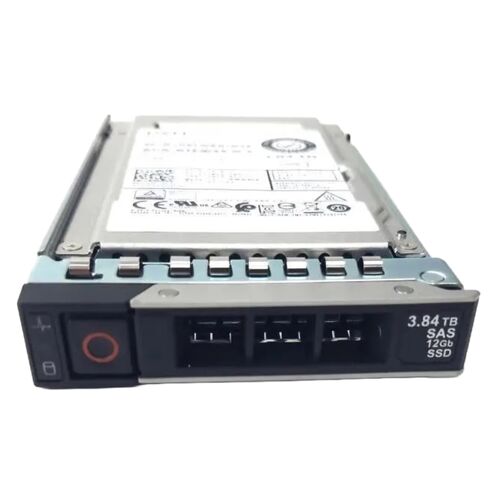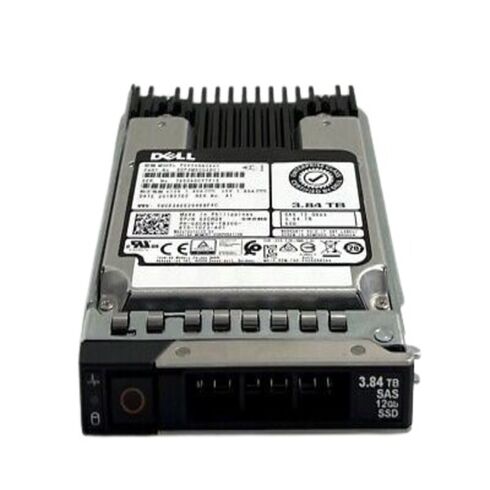XCRDV Dell 3.84TB SAS 12GBPS 512N Hot Plug SSD
- — Free Ground Shipping
- — Min. 6-month Replacement Warranty
- — Genuine/Authentic Products
- — Easy Return and Exchange
- — Different Payment Methods
- — Best Price
- — We Guarantee Price Matching
- — Tax-Exempt Facilities
- — 24/7 Live Chat, Phone Support
- — Visa, MasterCard, Discover, and Amex
- — JCB, Diners Club, UnionPay
- — PayPal, ACH/Bank Transfer (11% Off)
- — Apple Pay, Amazon Pay, Google Pay
- — Buy Now, Pay Later - Affirm, Afterpay
- — GOV/EDU/Institutions PO's Accepted
- — Invoices
- — Deliver Anywhere
- — Express Delivery in the USA and Worldwide
- — Ship to -APO -FPO
- — For USA - Free Ground Shipping
- — Worldwide - from $30
Same product also available in:
| SKU/MPN | Warranty | Price | Condition | You save |
|---|---|---|---|---|
| XCRDV | 1 Year Warranty | $1,187.00 | New Sealed in Box (NIB) | You save: $415.45 (26%) |
| XCRDV | 1 Year Warranty | $370.00 | Excellent Refurbished | You save: $129.50 (26%) |
Specification of Dell XCRDV 3.84TB SAS SSD
Product Highlights
- Brand: Dell
- Model Identifier: XCRDV
- Drive Category: Hot-pluggable Solid State Drive
Technical Specifications
Storage Capacity & Flash Architecture
- Total Capacity: 3.84 Terabytes
- Flash Type: Multi-Level Cell (MLC) NAND
- Form Factor: 2.5-inch small form
Interface & Data Throughput
- Connection Protocol: SAS 12Gb/s
- Transfer Speed: Up to 1.2 Gigabits per second
- Sector Format: Advanced 512N layout
Performance Metrics
Read Efficiency & Bandwidth
- Optimized for: Read-intensive workloads
- External Data Rate: 1.2 Gbps peak throughput
Connectivity & Expansion Options
Interface Configuration
- Port Type: Single SAS 12Gb/s connector
- Bay Compatibility: 2.5-inch hot-swap slot
System Compatibility Matrix
Supported Dell PowerEdge Servers
- PowerEdge R340
- PowerEdge R440
- PowerEdge R540
- PowerEdge R640
- PowerEdge R740
- PowerEdge R840
- PowerEdge R940
- PowerEdge R940xa
- PowerEdge R740xd
- PowerEdge C6420
- PowerEdge R6415
- PowerEdge R7415
- PowerEdge R7425
Dell XCRDV 3.84TB RI MLC SAS 12GBPS SFF SSD Overview
The Dell XCRDV 14G 3.84TB Read Intensive MLC SAS 12Gbps 2.5-inch Hot Plug SSD is a high-performance enterprise-grade storage drive engineered to deliver exceptional reliability, scalability, and speed for data-intensive environments. Designed for 14th-generation Dell PowerEdge servers, this drive offers remarkable data throughput and endurance, enabling enterprises to optimize workloads across cloud, virtualization, and business-critical applications. Built on multi-level cell (MLC) NAND flash technology and leveraging a 12Gbps SAS interface, this SSD provides consistent low-latency access with superior data integrity features ideal for read-intensive applications.
High-Speed Data Transfer with SAS 12Gbps Interface
The Dell XCRDV 3.84TB SSD operates using the SAS 12Gbps interface, which significantly enhances data transmission speeds and bandwidth efficiency compared to traditional SATA drives. The Serial Attached SCSI protocol allows for full-duplex communication, improving performance in multi-tasking and multi-threaded workloads. With the 12Gbps SAS architecture, data moves faster between the storage device and the server backplane, resulting in lower latency and faster access to critical information. This makes the XCRDV SSD an ideal choice for database queries, business analytics, and large-scale virtual machine operations.
Advantages of SAS Interface in Enterprise Environments
SAS storage solutions are renowned for their superior reliability, command queuing capabilities, and dual-port functionality. The dual-port design ensures continuous data availability, even in failover scenarios, providing uninterrupted service for mission-critical systems. The Dell XCRDV SSD’s SAS 12Gbps interface allows it to integrate seamlessly into enterprise infrastructures, providing high IOPS performance and scalable connectivity. This reliability is particularly valuable in environments requiring sustained uptime, such as online transaction processing (OLTP), enterprise resource planning (ERP), and virtualization platforms.
3.84TB Storage Capacity and MLC NAND Architecture
The Dell XCRDV 3.84TB SSD is built using Multi-Level Cell (MLC) NAND flash technology, offering a balance between endurance, cost-efficiency, and capacity. MLC stores multiple bits per cell, delivering substantial storage density while maintaining enterprise-grade reliability. The 3.84TB capacity ensures that data-intensive applications and virtual environments can store vast datasets without sacrificing speed or durability. This large capacity drive is ideal for server caching, data warehousing, and virtual desktop infrastructure (VDI) workloads, where fast data retrieval is crucial.
Enterprise-Grade Endurance Rating
The endurance level of the XCRDV SSD is carefully calibrated to meet read-intensive usage scenarios, ensuring that the drive can sustain thousands of daily read operations with minimal wear. This endurance rating supports reliability in high-demand environments like database indexing or data mining applications. Dell’s validation process ensures that each SSD maintains consistent performance even under continuous workload stress.
Hot-Plug Functionality and Serviceability
The Dell XCRDV 14G SSD is engineered with a hot-plug design, enabling seamless replacement or upgrading of storage drives without the need to power down the server. This feature greatly improves system uptime and reduces maintenance-related downtime. IT administrators can remove or insert the SSD during operation, ensuring uninterrupted business continuity in data centers and enterprise infrastructures.
Optimized for Dell PowerEdge 14th-Generation Servers
This SSD is purpose-built for Dell PowerEdge 14G servers, ensuring perfect compatibility and integration with Dell’s server backplane, firmware, and management software. The drive’s hot-plug design aligns with Dell’s front-accessible storage bays, making installation and replacement simple and efficient. With support for Dell OpenManage tools, IT teams can easily monitor drive health, temperature, and performance metrics, streamlining system management.
Read Intensive Workload Optimization
As a read-intensive SSD, the Dell XCRDV 3.84TB is optimized to deliver exceptional read performance while maintaining power efficiency. It excels in workloads where data is primarily accessed for reading rather than frequent writing. Examples include streaming applications, media servers, and analytical processing systems where consistent data access speed is paramount. The read-optimized firmware ensures quick response times, making it suitable for workloads that require fast query resolutions.
Performance Efficiency in Data-Heavy Applications
This SSD ensures superior input/output performance, enabling faster data retrieval and reduced latency in applications involving large-scale data queries. The optimized firmware intelligently handles queue depths and access patterns typical of read-intensive tasks, achieving low latency and stable throughput. With the 12Gbps interface and MLC flash, the drive consistently delivers high-speed access across multiple parallel requests.
Enterprise-Grade Reliability and Security
Reliability and data integrity are critical for enterprise storage, and the Dell XCRDV SSD includes advanced technologies to ensure consistent operation. Features such as end-to-end data path protection, power-loss protection, and advanced error correction mechanisms safeguard data at every stage of transmission. These protective measures ensure that information remains intact and accessible, even during unexpected system interruptions.
End-to-End Data Path Protection
The SSD’s data path protection ensures that every bit of data transmitted from the host to the NAND flash is verified and validated for integrity. This feature eliminates the risk of data corruption due to signal interference or unexpected errors during transfer. Such comprehensive protection makes the Dell XCRDV an excellent choice for mission-critical storage arrays where accuracy and consistency are paramount.
Compatibility and Integration with Dell Ecosystem
The Dell XCRDV 14G SSD is certified and validated for integration within Dell’s PowerEdge and PowerVault systems, ensuring optimal performance and long-term dependability. Dell’s rigorous testing guarantees firmware-level compatibility, ensuring the SSD operates harmoniously with server BIOS, RAID controllers, and management software. This deep integration allows enterprises to deploy the drive confidently in large-scale infrastructures.
Compatibility with Dell RAID Controllers
The drive supports Dell’s PERC RAID controllers, offering enhanced redundancy, performance, and fault tolerance. IT administrators can configure RAID arrays to balance performance and data protection efficiently. The SSD’s firmware is tuned to ensure reliable communication with Dell’s RAID controllers, delivering predictable performance under diverse workloads.











